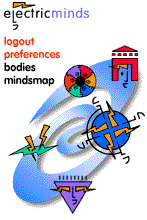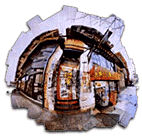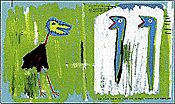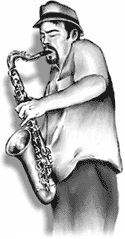
|

|
|
new york - mark mcclusky
An Alternative Music Knitwork
Ten years ago, Michael Dorf arrived in New York as the manager of an obscure Wisconsin band called Swamp Thing. As Dorf realized that Swamp Thing wasn't going to set the world on fire, he and his friend Louis Spitzer found an abandoned Avon office on Houston Street between Bowery and Broadway, which they rented for $1,800 a month. The two men renovated it into a club that, as they said at the time, they hoped would "weave strands of disparate art media into a congruent whole." They named the fledgling club after a proposed Swamp Thing album title, and the Knitting Factory was born. Now the club is looking at the World Wide Web as another opportunity to intermingle those strands of art -- an effort that could make the Knitting Factory a worldwide force. To celebrate its tenth anniversary, the Knitting Factory put together an astonishing February 1997 lineup of rock, jazz and other performances. Among the Musicians ho appeared included Violent Femmes, Bob Mould, Alex Chilton, Mike Watt, Yo La Tengo, John Zorn, Bill Laswell, Richie Havens, Philip Glass, John Lurie, Geri Allen, Don Byron,Eric Bogosian and Laurie Anderson. The lineup inspired me to attempt to spend the entire month at the Knit, sleeping in the bar if they would let me. Unfortunately, the reality of my job and the scarcity of tickets limited me to three of the shows. Dorf and the Knitting Factory have left behind their first home, moving into a four-story, indie megaplex on Leonard Street in Tribeca. Sitting in the downstairs bar, I thought of the club's incredible constancy through the many music-world changes since it opened. "Whether we work as a club, a recording label, a touring agency, a festival producer, an internet site... we are simply a conduit to the wonderful world of art," writes Dorf in the Knitting Factory's promotional magazine Knotes. The Knitting Factory's 1987 opening filled a void in the New York club scene: bands and artists needed a supportive, open setting in which to explore their music. The Knit addressed that need spectacularly -- especially in the highly stratified world of jazz. Large established jazz clubs like the Blue Note were caught up in a star system that limited their bookings to big names; the Knitting Factory gathered musicians like Lurie and Zorn, Fred Frith and Wayne Horvitz. The jazz that these players loved was less structured, more free-form and more global in its influences. Given a focal point for their music, these players (and others drawn into their orbit) coalesced into what has come to be known as the "downtown" jazz scene in New York. The Knitting Factory gave these musicians a place to play and a forum for their art. It was a textbook example of a club that moves past being a business to become an integral part of the artistic community. "The Knitting Factory decided: 'come and play here, let's build a house, let's get another show happening,' and the result is the opposite of what usually happens in business situations," says Zorn on the Knitting Factory web site. "It is the artists who made the image of this place." As the years have passed, the Knitting Factory has branched into other enterprises. Its "What Is Jazz?" festival has become a major competitor to the long-running JVC Jazz Festival. The club also started a record label, Knitting Factory Works, to help distribute the work of its core artists around the world. And with the emergence of the World Wide Web, the Knitting Factory has established one of the more rewarding sites around. At the Knitting Factory site, not only can you find information on upcoming shows at the club and about the Knitting Factory Works label, but you can also see many of the club's shows live. The Knitting Factory has moved aggressively to cybercast shows on the net. The club is positioning itself as a hub in a community once again; but this time, it's a community around the globe that can now be a part of the downtown scene. Dorf says he hopes to develop "a network of Knitting Factorys in strong music communities such as London, Paris, Amsterdam, Tokyo, Shanghai, Toronto and Los Angeles. When we can develop a strong local scene of musicians in various places, then we can literally plug them into our 'knitwork' of a company, via fat pipelines between the clubs, creating virtual stages. The Net is the ultimate and ideal way to connect all the dots." In its ten years, the Knitting Factory has moved from an abandoned office to an internationally renowned venue and record label. With the club's presence on the web, and the promise of more bandwidth for us all in the future, the next decade might see a Knitting Factory on every desktop. |
jenb said: I'm still a long way from taking the leap to calling myself a San Franciscan. I still feel like I'm just visiting, and I'll always be a New Yorker. My good use for a displaced NYer? Well, that's easy! A displaced NYer can always be counted on to give it to you straight when everyone else is doing the placating, non-confronational, "don't forget to breathe" schpiel. Most Active Topics: Topic 8 Only in New York... Topic 28 Bad ideas of the twentieth century Topic 25 The Psychologist is IN... | |||



| ||||
Also in New York: Starting Up, High Up An Alternative Music Knitwork A Tale of Two Cities: New York in Berlin | ||||
|
|
|
electric minds |
virtual community center |
world wide jam |
edge tech |
tomorrow |
conversations
Any questions? We have answers.
©1996, 1997 electric minds, all rights reserved worldwide.
|
